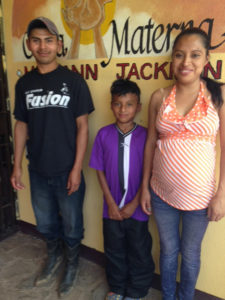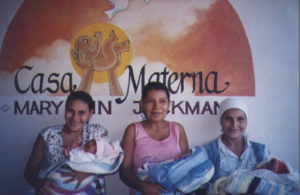
Luis Enrique, Alexis & Maria Fatima
When Maria Fatima arrived at the Casa Materna in mid-July, she looked around thoughtfully taking in every aspect of her surroundings. Then she said, “I was here almost ten years ago, and I am remembering how it was. I was only 14 years old and about to give birth to my son. It was October, and I named my son for the famous Nicaraguan boxer Alexis Arguello. I hope that Alexis can come and visit me before his sister is born.”
Gradually, Maria Fatima shared her life story. “I was just 8 years old when my mother gave birth to my younger sister. I had 2 older sisters and a brother. Then, when the baby was only 3 months old, my mother became very ill and died suddenly. For all of us, including my father, there was so much sadness.”
Maria Fatima’s story of her teen pregnancy is not that different from others who have come to the Casa Materna from their rural homes to give birth in the Matagalpa Regional Hospital. First births in Nicaragua are considered high risk by the Ministry of Health (MINSA) but especially so for teen mothers who account for 1 in 4 births. One risk factor in our rural region is the distance from the hospital but another has to do with the stature and development of a young mother.

New moms and babies at Casa Materna Mary Ann Jackman
Had Maria’s mother been there to accompany her, might it have been possible that she would have attended school and not been seduced into becoming pregnant with her boyfriend who was 4 years older? As it turned out, the father of Alexis was alcoholic and actually died from his disease in his early twenties when his son was just 3 years old.
Four years ago when his mother met and married his stepfather, Luis Enrique, Alexis knew the joy of having a father. When Alexis and Luis came to visit, it was evident how much his adoptive father cared for his son, and Maria proudly told us what a wonderful artist he is. It was with joy that the family of three awaited the planned birth of Alexis’ sister.
From our first year in 1991, the risk factor of age, either older or younger, was very evident. Twenty-five percent were mothers over 35, many of whom were about to give birth to their 10th, 12th or even 15th child. Our oldest mother was 50 and about to have her 19th.
At the same time, mirroring the statistics in all of Nicaragua, some 25% of our mothers each year were under age 20. Most often the pregnancy, even when not planned was “wanted” (i.e. the young mother was “accompanied” by the father even if not formally married, and the father was committed to caring for his family). At other times there have, sadly, been instances of rape or incest.
As many girl children in rural communities do not have access to education beyond the 6th grade, and many don’t even make it that far, the idea of bearing a child at 16 or 17 (and even 15) years of age is not out of the norm. Many Casa mothers still tell us, “My mother gave birth to me when she was just 15 or 16.” And some will share solemnly, “My mother (or grandmother) died in childbirth.” It is not unusual to hear from a 23 year old mother returning to the Casa: “I was here to give birth to my first child when I was just 15 and now,” she adds with pride, “My husband and I are having our second child, a child we have planned for.”
As MINSA takes on the mission of creating more Casa Maternas (now over 170 while Casa Materna MAJ was the 2nd), our staff continues to develop educational programs and strategies focused on reducing teen pregnancies in our mountainous region. Our Follow-up Program attending 400+ former Casa mothers in 12 communities is supplemented by the Outreach to Adolescents program funded by friends from Switzerland.
As we approach the 25th anniversary of the Casa Materna MAJ in late October, we celebrate the more than 17,650 mothers and newborns. And we give thanks for international solidarity, including the faithful support of ProNica friends that continues to make possible this vital service for rural mothers.
